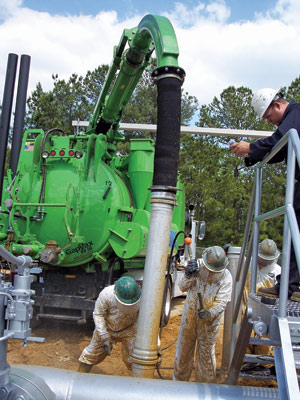Every contractor has a go-to machine – one piece of equipment that always comes through in the clutch on a tough job, with capabilities to open doors to new business. For Defiance Energy Services LLC in Minden, La., about 30 miles east of Shreveport, that go-to guy is an HV56 hydrovac truck made by GapVax Inc.
In fact, to hear company owner Bear Starkey tell it, the HV56 – which performs hydroexcavating as well as heavy-duty dry and wet vacuuming – is so critically important that without it, Defiance Energy’s competitors would have one less company to worry about.
“I’ll be honest with you: If we hadn’t bought the truck, I don’t think we’d still be in business today,” Starkey says. “It allowed us to expand into flow-back tank and rig cleaning and into hydroexcavating. Customers really started hammering on having one company do all the work instead of two separate companies (one doing rig cleaning and another doing tank cleaning). They want a one-stop shop where they only need to send out one bill. With this truck, we can do both kinds of work.”
Much of Defiance Energy’s work supports natural-gas drilling operations on the Haynesville Shale, an immense natural-gas play that lies about 2 miles underground in northwestern Louisiana and East Texas. Defiance originally went out on a limb and invested in the truck about two years ago, mainly to clean out the mud tanks stationed at drilling rigs to collect drilling mud.
A typical mud tank might consist of eight different compartments that, in total, hold anywhere from 63,000 to almost 100,000 gallons of mud. “It takes about 24 hours to clean one of those tanks,” Starkey says. “The stuff is oil-based, and it sticks to everything, so you’re pretty much just chasing it. It gets stuck to the walls of the tanks, so our guys have to get in there and wash them down.
“We might fill that truck up 10 times or more while cleaning a typical tank,” he adds. “To keep the truck working continuously, we hook it up to transport trucks and off-load mud to them, then they take it away for disposal.”
With vacuum power rated at 5,300 cfm with an 8-inch hose, the HV56 is up to the task. Starkey says his men use a 4-inch hose and are able to maintain vacuum strength of 3,500 cfm while cleaning. The truck is also equipped with a 15-yard debris tank (about 3,000 gallons); a 1,200-gallon water tank; an optional 4-inch sludge pump for off-loading liquids and semi-solids; and 190 feet of hose.
“On some jobs, because there’s so much equipment on a drilling site and space is tight, we use all 190 feet of that hose,” Starkey explains. “The tanks are about 150 to 300 feet long, and we usually have to park on one end and run the (hose) all the way to one end and work our way back. That would be impossible to do with a regular vacuum truck. This (unit) sucks just as strong from 190 feet away as it does from 10 feet away.”
The truck also holds its own while cleaning out tanks filled with flow-back sand, a byproduct of the rock-fracturing process used to reach gas deposits. A typical tank holds about 8,400 gallons of material, but Defiance crews usually clean them when they’re about half full, mainly to keep the truck below mandated weight limits.
“We usually suck about 40 or 50 barrels (1,680 to 2,100 gallons) at a time, every 18 hours or so,” Starkey says. “The well shuts down for that kind of maintenance, so we have a limited window of time to work with – speed is important.”
For hydroexcavating, the truck’s waterjet flow is rated at 2,900 psi at 19 gpm. Defiance mainly hydroexcavates pipelines in older natural-gas plants. “If they’re replacing lines, or tying in new lines, or there’s a leak and a line needs to be replaced, we go in and hydroexcavate, which is a much safer way to work on live lines than traditional excavation equipment,” he says.
Just how valuable is the HV56? While declining to name specific figures, Starkey estimates his company’s monthly sales revenue is roughly ten times greater than it was two years ago, which is a substantial amount of money. And he expects the truck to help Defiance Energy expand its customer base even more in the years ahead.
“The truck has allowed us to really expand revenues by diversifying,” he notes. “That one truck has generated enough business to justify us leasing two more and buying another one.
“And there are a lot more things the truck can do that we don’t go after right now, because we’re not geared up to do it,” he adds. “But if we ever decide we want to, we now have the ability to do so.”





